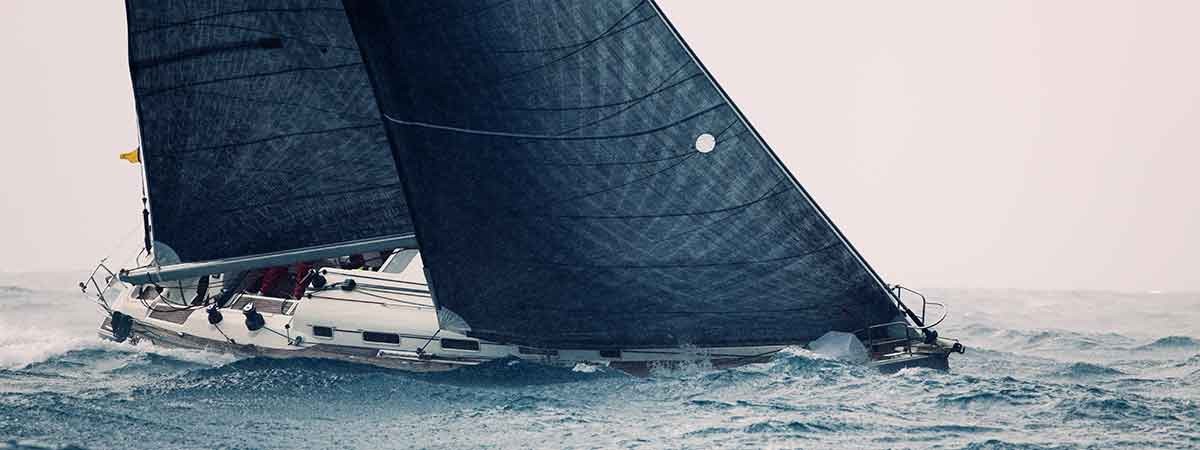Modern sailing yachts catch the wind using high-performance sails, for which geometry, material and fibre flow are calculated down to the smallest detail. Vacuum is indispensable for connecting the various layers of the high-tech cloths.
The early Polynesians conquered the Pacific with simple outrigger boats. Their sails were fashioned of woven leaves from the pandanus tree. In other parts of the world, sailors used fabrics made of all available fibers such as linen, nettle, wool, cotton or silk. Sometimes the way they harness the power of moving air was less than efficient – after all, these traditional sail cloths were anything but windproof. They also became completely soaked with water and were not immune to mold and parasites.
Synthetic fibres get things going
It is therefore no surprise that synthetic fibres and films quickly became established in the production of sails. Apart from a nostalgic appearance, modern sail cloths are superior to traditional fabrics in every respect. They are practically immune to the previously unavoidable rotting; they are much lighter, yet more stable, and as they have no pores and are therefore air impermeable, they can perfectly capture the wind.
This is another reason why today's yachts are dramatically faster than the old sailing ships. While they used to bob up and down across the oceans at less than ten knots, boats in the America's Cup have already reached over 50 knots (almost 100 kilometers per hour!). The sail surfaces, which can cover several hundred square meters, are subjected to correspondingly high forces in strong winds. These forces would be much too strong for classically woven cloths – even made of modern synthetic fibers.
Many-layered and three-dimensional
Sail makers' answer to the requirements of modern sailing are membrane sails, also called laminate or film sails. Their highly stable fibers are made of high-tech materials such as modified polyester, aramid, carbon or polyethylene. These fibers are glued to a thin carrier membrane or worked directly into it. They are aligned so that they run primarily in the direction of the highest loads. Additional layers can run in other pulling directions. Up to 400 layers come together for large maxi yacht sails.
The various layers are arranged in the desired manner, often requiring elaborate manual work. In this process, the sails also receive the desired three-dimensional profile. The connection between the layers is then created by laminating. In this decisive production step, the almost finished cloth is wrapped under vacuum in a film and impregnated with synthetic resin. The film is evacuated with a vacuum pump so that the resin can penetrate all pores and spread optimally. The natural air pressure then ensures even contact pressure and perfect distribution of the bonding material.

Wind catcher made of high-tech fabric
Modern membrane sails are laminated under vacuum
How big can a yacht sail be?
The question can be answered with one number: 2,602 square meters (or 28,010 square feet). This is the size of the largest single sail on the Seven Seas. It is the spinnaker of the one-masted yacht Perseus^3, which was built in the Italian shipyard Perini Navi in 2015. The cloth was developed especially for this boat, as no sufficiently stable fabric had been available for such dimensions until then. Its area exceeds the total sail area of many a majestic three-master. The Perseus^3 also has a lot to offer in this respect, with a record-breaking 10,000 square meters. At 75.8 meters, the mast on which the gigantic cloths hang is considered the third highest in the world. This means that the yacht cannot pass through the Panama Canal and is too high to pass under the Bridge of the Americas.
The question can be answered with one number: 2,602 square meters (or 28,010 square feet). This is the size of the largest single sail on the Seven Seas. It is the spinnaker of the one-masted yacht Perseus^3, which was built in the Italian shipyard Perini Navi in 2015. The cloth was developed especially for this boat, as no sufficiently stable fabric had been available for such dimensions until then. Its area exceeds the total sail area of many a majestic three-master. The Perseus^3 also has a lot to offer in this respect, with a record-breaking 10,000 square meters. At 75.8 meters, the mast on which the gigantic cloths hang is considered the third highest in the world. This means that the yacht cannot pass through the Panama Canal and is too high to pass under the Bridge of the Americas.